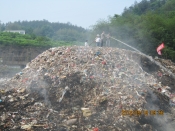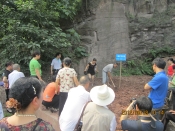 Industrialisation and urbanisation have brought a great variety of glittery commodities. However, material prosperity has its cost. Perpetual consumption results in waste piling up. When we throw garbage out of our houses, we may like to think that it vanishes forever. In reality, our waste can return quietly and punish us for our reckless behaviour. When it rots, garbage releases waste water and may also release toxic substances. Left untreated, they flow into streams, rivers and fields, get in our food and end up on our tables, resulting in food poisoning and chronic diseases…..
Industrialisation and urbanisation have brought a great variety of glittery commodities. However, material prosperity has its cost. Perpetual consumption results in waste piling up. When we throw garbage out of our houses, we may like to think that it vanishes forever. In reality, our waste can return quietly and punish us for our reckless behaviour. When it rots, garbage releases waste water and may also release toxic substances. Left untreated, they flow into streams, rivers and fields, get in our food and end up on our tables, resulting in food poisoning and chronic diseases…..
We can no longer ignore the waste problem—a product of modern civilization. Mainland China is experiencing a period of unprecedented economic growth. In the meantime, cities and towns are under siege by waste, and the situation of towns are particularly neglected. In 2006 Xiao Er Township in Gong County, Yibing, Sichuan Province was faced with such a crisis. Since there was no waste treatment system, people dumped their garbage outside of the local government office. The rubbish piled up so high that the windows of the government office were blocked and the stench was so strong that government officers simply could not ignore the problem. The local government collaborated with Partnerships for Community Development (PCD) and a pioneer pilot project on waste separation was launched in 2007. After six years of trial, most people of Xiao Er Township now attach greater importance to waste treatment and they are much more aware of the issue than before. Moreover, the volume of greenhouse gas emissions of Xiao Er has gone down which in turn contributes to improving the environment.
In Xiao Er, garbage is divided into dry and wet waste at source, i.e. at home. Wet waste is organic and biodegradable. It is recycled into compost and methane gas,which is then distributed to farmers around the township. Compost is used for farming while methane gas is used for home cooking. Other waste like plastic materials and glass are to be recycled. What remains after sorting will be disposed of in a landfill.
PCD Emphasises on Environment Education
PCD has been giving support to the project mainly by supporting environmental education organised in the form of community activities in which local people reflect on the relationship between consumption, the waste problem and everyday life in modern society. In the process, concepts of sustainable living are promoted. While the local government is responsible for the clearing and burial of garbage as well as composting, PCD, which has injected an equal amount of capital into the project, provides supervision. Funds from the government are mainly used for human power, clearing and transportation of waste as well as fixed assets such as garbage trucks, while those from PCD are mainly used for training, workshops and environmental education.
After six years of trial, PCD commissioned the Sustainable Research and Education Centre of the College of Architecture and Environment of Sichuan University to study Xiao Er Township's waste separation and treatment project in terms of economic cost, characteristics of the local people’s waste separation behaviour and attitude, and the impact of the programme in reducing greenhouse gas emissions. The study was completed last year. Detailed scientific data output and recommendations were provided.
According to the study, the impact of the project includes the reduction of greenhouse gas emissions, which is the most meaningful part regarding the mitigation of global warming. Based on the volume of garbage generated and types of waste classified, the study divides waste treatment systems into four forecast scenarios—“no separation”, “a little separation”, “medium level of separation”, and “ advanced level of separation”. The volume of greenhouse gas emissions is estimated for each scenario. The waste separation system of Xiao Er Township belongs to the second type, i.e. “a little separation”. In 2011, a total volume of 4,753 tonnes of waste was generated in Xiao Er. The study estimates that if there were no waste separation system, the volume of greenhouse gas emissions would be 4,626 tonnes of carbon dioxide equivalent (CO2e) [1]. It is estimated that after the implementation of “a little separation”, the volume of greenhouse gas emissions would be 4,461 tonnes of CO2e [2], a reduction of 165 tonnes of CO2e.
Positive Impact Recorded Six Years Later
According to the study, the economic cost of waste separation is low, helping reduce the final cost of waste treatment. The cost includes clearing and transportation of waste, terminal processing (infrastructures for landfill, composting and methane gas production), management, project supervision and staff expenses, community publicity and education, external experts and capacity building, etc. Between 2007 and 2012, the cost of implementing waste separation was RMB 110/tonne which was lower than the cost of non-separated waste treatment (which includes clearing, transportation and final disposal) in other cities in mainland China. For example, in Huizhou City in Guangdong Province, the cost of waste treatment was RMB 163.44/tonne in 2004-2005. In 2012, the local government of Xiamen City paid RMB170 for each tonne of waste incinerated.
In Xiao Er Township, recycling waste has not brought direct economic benefits to the civic authority because the compost and methane gas are provided to farmers free of charge. There are, however, indirect economic benefits. The number of recycled waste collectors in the township has increased from two to eight.
Using questionnaires, the researchers interviewed 182 Xiao Er residents among whom 67% responded that their families had been dividing their garbage into wet and dry waste according to instructions given to them. Only 11.5% of those interviewed had not been sorting their garbage. In terms of their attitude towards waste separation, both positive and negative responses were recorded, but the majority attitude appears to be positive. This shows that local people’s awareness of waste separation and environmental health has grown, thanks to the efforts of the local government and PCD over the last six years.
The study has made a number of recommendations for the continuation and future implementation of the waste separation programme. They include increasing the efficiency of waste separation, reducing the volume of waste to be cleared and transported, and reducing the volume of waste for burial. The study has also found that toxic or chemical waste (used batteries, old fluorescent light bulbs and bottles for pesticides and chemical fertilisers) has been improperly disposed of. Only one third of families dispose of these types of waste separately. Some families even dump them into natural watercourses, causing pollution. It is recommended that education and publicity in this matter be strengthened.
The experience of waste separation in Xiao Er Township shows that garbage treatment is everyone’s responsibility. Everyone contributes to garbage creation every day. If the waste is not treated appropriately, our holistic health will be affected. The effort of any one government department or organisation is not enough, in itself, to solve the garbage problem. Everyone must take part in solving the problem since we all play a part in creating it.
According to Dr. Lu Hong-yan of the Laboratory of Solid Waste Reuse at Sichuan University, we should not use a single, intensive method to deal with our waste problem, such as burying all the garbage in one place. This is not sustainable because the landfill would very soon be filled up. A long term, sustainable strategy is to have a system that combines different methods of waste treatment, including the reduction of garbage at source (for example, reducing packaging and use of plastic bags), separating the waste generated, and recycling garbage. Only the waste that remains after this process should be sent to landfill.
PCD has produced a short film on the experience of waste separation in Xiao Er Township and sustainable approaches to waste treatment. The title of the film is “Reversed Assault” which is a term used by online game players to emphasise the importance of positive energy and the spirit to strive for improvement. It was chosen as the title of the film to describe waste treatment plans that are community-based and start from grassroots level. Although grassroots people have limited power at the individual level, when they collectively and determinedly exert themselvesin practising sustainable living , they are powerful enough for a “reversed assault”. The idea behind the waste separation system combining various methods was explained in detail by Dr. Lu Hong-yan in the film.
Please click the link below to watch “Reversed Assault”, a film about the experience of waste separation in Xiao Er Township and other efforts made by the grassroots to address the waste problem: http://v.youku.com/v_show/id_XNTQ2MzU1OTYw.html
Photo sharing:
+ Click thumbnail to enlarge photo
 In the past when Xiao Er Township did not have an effective waste treatment system, the river was filled with garbage.
In the past when Xiao Er Township did not have an effective waste treatment system, the river was filled with garbage.- Volume of carbon emission is used to measure the total volume of all types of greenhouse gas generated by human activities and in production or consumption of a certain commodity. It involves mainly the consumption of fossil fuels such as gasoline in our everyday activities or in the production of goods and use of electricity, and the generation of other greenhouse gases such as methane or N2O produced by organic waste. The unit of measurement of carbon emissions is t CO2-eq/yr which is equivalent to metric tonnes of carbon dioxide emission per annum. Since there are other kinds of greenhouse gases apart from carbon dioxide (such as methane), other gases are converted into equivalent volume of carbon dioxide emissions to show their impact on greenhouse effect. That is why t CO2-eq/yr is used.
- The volume of greenhouse gas emissions in Xiao Er Township after waste separation was implemented is calculated by adding volume of greenhouse gas emissions generated from recycling waste to the volume of greenhouse gas emissions when residual waste is treated in landfill.







